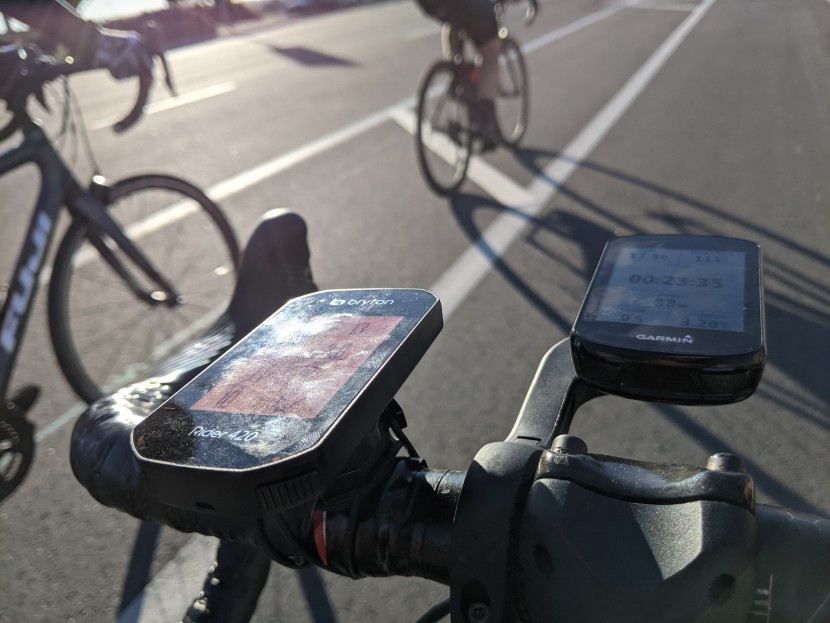A bike computer is an optional accessory, but very useful and convenient. Their prices are quite low, and more and more cyclists are purchasing these devices.
After all, it is always interesting to find out: how much I dashed off for this trip and in total for the season, at what speeds I drove, and other interesting and useful information that this device provides.
First of all, let’s look at the types of bike computers:
1. Magnetic
These are the simplest and cheapest types. In them, a magnet is installed on the spoke of the front or rear wheel, and a sensor with a reed switch is attached to the fork or, if on the rear wheel, then to the feather.
The reed switch (hermetic contact) is an electromechanical device in which contacts are hidden in a sealed flask that closes the electrical circuit when exposed to a magnetic field.
Those. When passing by the reed switch of the magnet fixed on the spoke of the wheel, the electrical contacts in it are closed, and the computer counts one revolution of the wheel. The wheel turned further – the magnet stopped acting on the reed switch, and the circuit opened. And depending on the wheel circumference entered during setup, speed, distances travelled, and other parameters are calculated.
- Advantages of magnetic bike computers
- Small size and weight
Good accuracy when properly tuned. At low speeds, for example, when going uphill, the magnetic sensor determines the speed and distance even more accurately than a GPS computer. For travellers and lovers of “deaf corners”, mountain gorges, etc., there is no need to depend on losing a signal from the GPS satellite and all sorts of “magnetic storms”.
Low power consumption – the battery in them lasts a very long time. Often it is enough for 2-3 years.
Dustproof and waterproof – they are not afraid of rain, although it is better to take them off when washing the bike.
They have good impact resistance. They are small, so they often do not even touch the ground when the bike falls.
Cons of magnetic bike computers
If there are inaccuracies in setting the distance between the magnet on the spokes and the reed switch on the fork, or if the wheel circumference needs to be entered correctly, the accuracy of the calculations decreases.
- Difficulty transferring from one bike to another. It is necessary to remove all sensors, wires, etc. But if you only ride one bike, it doesn’t make sense.
- Knocking or moving the magnet and sensor on the fork when travelling over rough terrain is possible.
- The possibility of a wire break, especially when travelling through mountains, forests, etc.
Magnetic bike computers are:
Wired. In them, the computer and the sensor are connected by a wire. These are cheaper models.
Wireless. The computer and the sensor have their batteries and communicate with each other via radio or Bluetooth. Usually, the data transmitted over it is encoded or encrypted so that when riding in a group, such computers and sensors do not confuse each other on different bikes.
They are more expensive than wired ones, but the bike looks neater – no wires exist.
Some wireless models also have separate sensors attached to the cyclist and measure heart rate or to the pedal and frame to measure cadence. They often have two reed switches combined in one sensor housing to measure cadence and speed, which is placed on the rear wheel.
There are bicycle computers with additional functions like an altimeter, a thermometer, and a psychrometer. But these are already more advanced devices and are used most often by professionals to prepare for competitions. Their cost can reach up to $200.
By the way, installing wired models on electric bikes is better. This is because magnetic fields and electrical interference during engine operation can lead to malfunctions due to the generated interference.
This also applies to Chinese models that stop working when the taillight is turned on. So when choosing, carefully read the reviews on the forums about them.
2. GPS bike computers
They use a satellite signal to determine distance, speed and other parameters and work as navigators. These are expensive and complex devices that require constant recharging. Like advanced magnetic ones, they calculate and give out a lot of additional characteristics and usually cost $200.
Some models can export their data to personal computers or smartphones.
Pros:
Ease of use. Just put it on the bike and go. No sensors or settings are needed. Very easy to transfer from one bike to another. Moreover, in many models, keeping records for each bike separately is possible.
High accuracy, regardless of the correct input of the wheel circumference and the shift of the magnet on the spoke or the reed switch on the fork.
Good display
The presence of the route navigation function is a big plus when travelling in unfamiliar areas. Some models have an altimeter function – altitude readings- especially useful in mountainous areas.
Minuses:
- Short battery life and the need for regular recharging.
- Weak impact resistance, based on the large size.
3. Smartphones and other devices.
You can use a fitness tracker, a GPS watch in cycling mode, or smartphones with specialized programs such as a bike computer.
For example, these programs include VeloPal, Map My Ride+, Ceclemeter, iBiker, Runtastic Road Bike PRO, and RunKeeper.
A special waterproof case and bike mount are required when using a smartphone.
You can also use specialized bike bags mounted on the frame’s top tube and have a special compartment for a smartphone.
It should also be noted that continuously running GPS and the screen on will quickly consume battery power, and a smartphone will survive a fall much worse than a magnetic computer.
These options will not be considered in this article.
The pros and cons of using a smartphone with the program are almost identical to GPS bike Tracker computers.
What to look for when choosing a bike computer
Necessary information
Before choosing a bike computer for yourself, decide what information you need.
Given the range of prices and functions performed, the choice of models is very large – why overpay for something you won’t use?
If you make ordinary trips for health and pleasure, use a bicycle as a means of transportation to work, a summer residence, etc. Ordinary models of wired magnetic bicycle computers will suit you. They are the cheapest, most reliable and show all the main characteristics.
If you can only live with bike trips, build complex routes for yourself and count everything you can, then you already know what you want from this device. You need an advanced GPS computer with a navigator and other features.
We will not talk about professional athletes. They need to know everything: from mileage to calories burned, to compare training results, build graphs, forecasts, etc. They need professional equipment, which they, along with the coaches, know everything about.
Backlight
If you ride both in daylight and at night, pay attention to the possibility of backlighting the display; otherwise, it will be useless in the dark.
Display type and data display
On some computers, all information is displayed rigidly. Still, you can change the type of information displayed on most by pressing the control button or setting the cyclical repetition of important indicators. For example, in a circle, every 4 seconds, the current speed, distance travelled, and travel time are shown.
Not unimportant nuance: the clarity of the image and the visibility of the data on display on a bright sunny day. Usually, in bright light, information on magnetic computers is best seen.
Please pay attention to the size of the screen and the numbers on it. Please note that you will have to look at the display during the trip when you cannot be distracted by looking at the numbers for a long time, especially since it trembles during the trip. Therefore, the image must be clear, of the right size, and located in a convenient location.
Some computer models have more than one display, each displaying only one type of information. For example, on one display is the distance travelled, and on the other is the speed and travel time.
The convenient location of control buttons
Switch modes, starting a stopwatch, etc., often happen during a trip, so the convenience of the location of the buttons and their sensitivity can have a decisive influence on the choice of device.
If you can not press the button during the trip – why do you need such a device?
Energy Efficiency
Everything is simple here. The more complex and smarter the device, the more it consumes electricity, and the batteries or accumulators last for a shorter period.
Ordinary magnetic bike computers using flat batteries, such as CR2032, and AG13 (LR44), will work on them for up to two years.
- GPS computers on one charge work about 15-20 hours.
- Smartphones, depending on the model, take about 8-12 hours.
Possibility of additional fastening
Usually, magnetic bike computers are attached to the handlebars or handlebars with double tape and ties. Still, some cyclists use special additional fasteners to position them more conveniently.
Data transfer
Simple cycle computers cannot transfer data to a personal computer. Therefore, if you need to transfer data to specialized programs on a PC, you must purchase advanced GPS models or smartphones.
Although, for 95% of cyclists, this is not necessary.
optionalicle will consider how to properly install a purchased bike computer on a bike.

